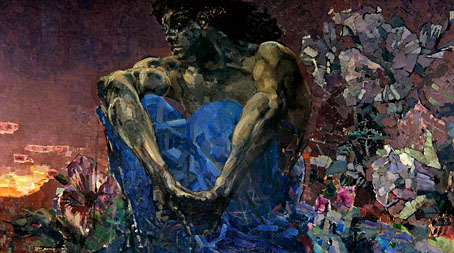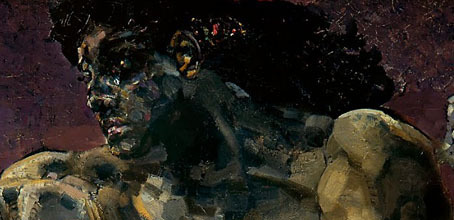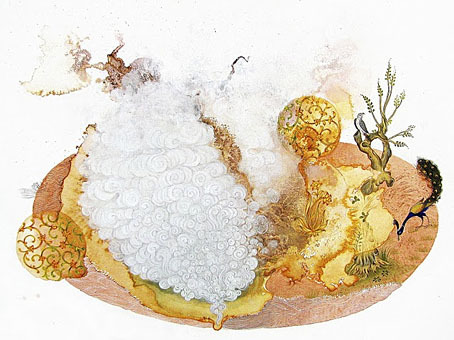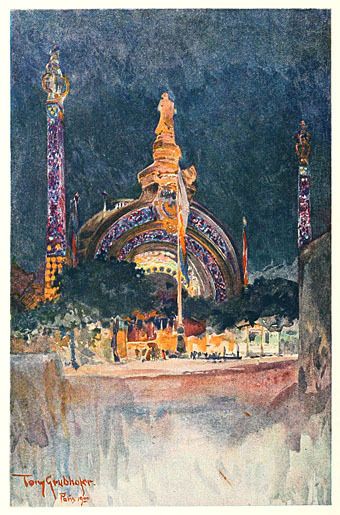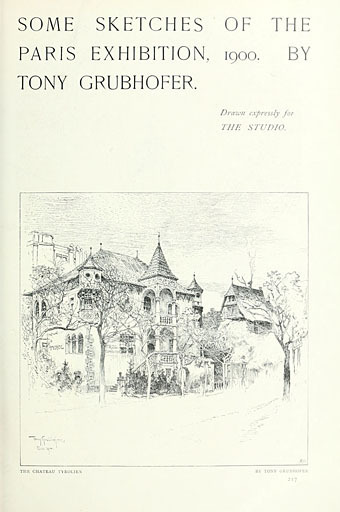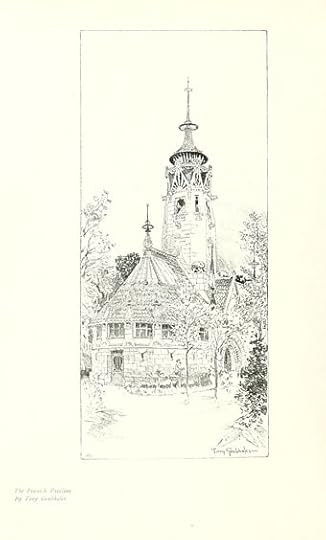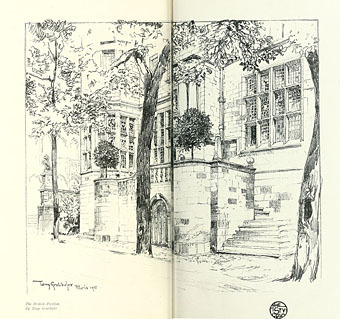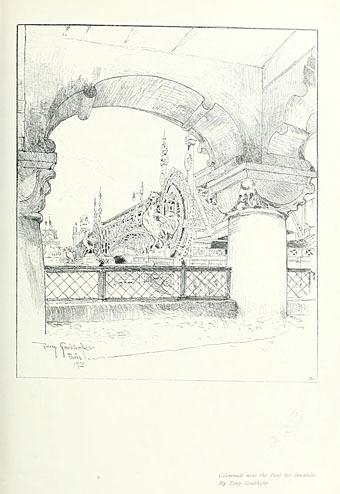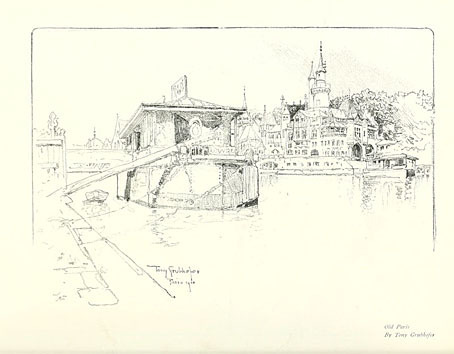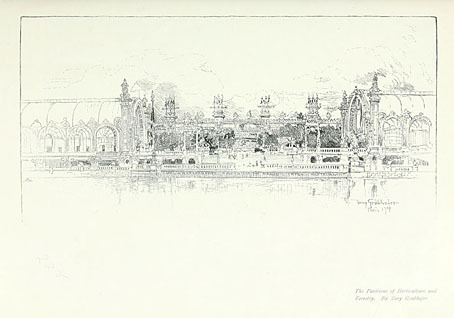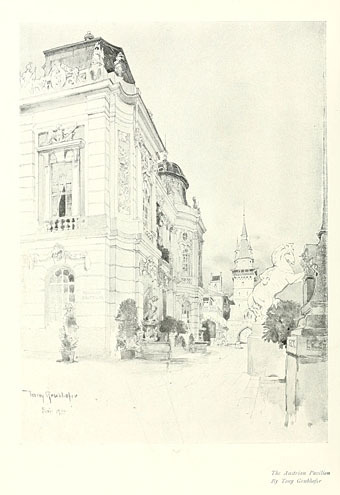John Coulthart's Blog, page 302
August 3, 2011
The fantastic and apocalyptic art of Bruce Pennington
The Pastel City (1971), the first in M. John Harrison's peerless series of Viriconium books.
Today's post is another guest entry over at Tor.com. I'd been intending on writing something about Bruce Pennington's art for some time, having already covered the work of Ian Miller, my other favourite genre cover artist of the 1970s. (By coincidence both artists have illustrated the work of M. John Harrison and HP Lovecraft.) My hand was forced this month by the news of the first ever exhibition of Pennington's paintings which is being held at Britain's foremost occult book emporium, the Atlantis Bookshop in Museum Street, London. There's a catalogue of the works on display here, many of which will be for sale. If I had the cash I'd consider buying one, Pennington's work made a big impression on my imagination when I was reading many of the titles he'd illustrated for the first time. His art was unique for me in its occasionally Surrealist overtones, and as a cover artist he was unusual in working across a range of genres. Like Frank Frazetta his imagination and technique were able to suggest a great deal with a minimum of brush strokes.
The Mask of Cthulhu (1976).
This post can be taken as an appendix to the Tor one which I didn't want to overburden with pictures. The Derleth cover is purloined from Jovike's excellent Flickr collection which includes several Pennington covers. Below are some pages from Pennington's first book, Eschatus, a large-format collection of paintings interpreting the prophecies of Nostradamus as an apocalyptic science fiction narrative taking place in the 24th century.
Pennington has many examples of his work on his website, and there's also a feature about his paintings in this month's Fortean Times. The Atlantis exhibition runs to August 27th.
Eschatus (1976).


Eschatus: back cover. A detail from a painting entitled Ghost Rider.
Elsewhere on { feuilleton }
• The illustrators archive
• The fantastic art archive
• The book covers archive
Previously on { feuilleton }
• The art of Ian Miller
August 2, 2011
The art of Leonidas Kryvosej
Andel západního okna.
Leonidas Kryvosej is a contemporary Czech Surrealist whose work I'd known for a while from an exhibition catalogue. I'd always wanted to see more so it's a pleasure to discover a substantial set of paintings on the website he shares with Lucie Hrusková. A biographical note tells us that:
Leonidas Kryvosej was born 14th May, 1957 in Moravská Trebová. He lives in Ondratice near Prostejov. He has been a member of the surrealist group in Sternberk (later A.I.V) since 1986. Since 1997 a member Czech and Slovak surrealist group.
Most of the text on the site is Czech-only but the green painting above was one of the catalogue works whose English title, The Angel of the Western Window, we can no doubt assume is borrowed from Gustav Meyrink's occult novel about Elizabethan magus John Dee. Occultism and alchemical symbolism seem to fuel Kryvosej's art, and I like the profusion of wings and mutated bird-like creatures. There's a lot of work on his gallery pages, all of it worth seeing for anyone who favours this kind of imagery.
Note: I've had to remove the caron accents from this post since either WordPress or the encoding I'm using has a problem with them. Apologies to Czech readers.
Ptací hra.
Elsewhere on { feuilleton }
• The fantastic art archive
August 1, 2011
Les Temps Morts by René Laloux
Is Les Temps Morts a French figure of speech? The phrase translates as "idle periods" as well as the more literal "dead times", so the title of this short film from 1964 may have some punning intent. This was René Laloux's second film as director, and one I'd not seen before until it turned up on YouTube. It's an oddly morbid piece not far removed in tone from yesterday's The Apotheosis of War but a dose of Surrealism courtesy of Roland Topor's minatory imagination rescues it from Vereshchagin's moralising.
Between some documentary clips of children play-fighting, war scenes, bullfights and bird shoots, Topor's scratchy ink drawings are brought to life with some minimal animation. There's also some narration in unsubtitled French. Laloux, Topor and soundtrack composer Alain Goraguer followed this with another, lighter short, The Snails (also on YouTube), in 1966 and joined forces again for Laloux's first animated feature in 1973, the justly-celebrated Fantastic Planet, a science fiction film that's a lot weirder than the usual Hollywood conceptions of the genre. That's been on DVD for a while, and is essential viewing for Topor aficionados.
• The schizophrenic cinema of René Laloux by Craig Keller.
Previously on { feuilleton }
• Taxandria, or Raoul Servais meets Paul Delvaux
July 31, 2011
Vrubel's Demon
Demon (sitting) (1890) by Mikhail Vrubel.
Another Symbolist painting ferreted out from the collections at the Google Art Project, this is actually one of a number of demon figures painted by Mikhail Vrubel (1856–1910). The subject marks it as Symbolist but the almost Expressionist style is very 20th century which makes its date of 1890 all the more surprising.
This is one of two Vrubels at the Google page for The State Tretyakov Gallery, Moscow. In the same collection there's also The Apotheosis of War (1871), Vasily Vereshchagin's timeless (if heavy-handed) canvas whose yawning skulls can now be explored in detail.
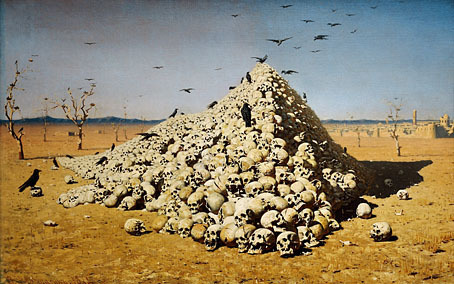
Previously on { feuilleton }
• Diaghilev's World of Art
July 30, 2011
Weekend links
PeacockApocalypse (detail) by Julie Evans in collaboration with Ajay Sharma.
Here at { feuilleton }, home of the curly bracket affectation, your correspondent is still surprised to find his postings the subject of a critique by Rick Poynor in the latest edition of Eye magazine, the international review of graphic design. I haven't seen a print copy yet but you can read Mr Poynor's appraisal here. Meanwhile, over at Design Observer this week there's another Poynor piece about the collage illustrations of Andrzej Klimowski.
• Alan Moore (yes, him again) discusses the moment when the League of Extraordinary Gentlemen gets all swinging and psychedelic. And Iain Sinclair (yes, him again) is still doing the interview rounds promoting his current book, Ghost Milk.
• Ayin Acla, a short film by Anna Thew with a soundtrack by Cyclobe. The most recent Cyclobe album, Wounded Galaxies Tap at the Window, was previously vinyl-only but is now available on CD.
• Bones and beads and other things in Wren Britton's Pure Vile clothing and accessories. Related: Patrick Veillet's wearable bone sculptures.
• Lambshead Cabinet of Curiosities Q&A: Ann & Jeff VanderMeer answer questions about their latest anthology at Fangoria.
• Being a lifelong introvert, I'm sympathetic to Four Ways Technology Can Enable Your Inner Introvert by Philip Bump.
• In an all-too-rare meeting of minds and talents, Roy Harper talks to Joanna Newsom.
• Jon Macy's Teleny and Camille is reviewed at Lambda Literary.
• Author Carol Birch tells us how best to read Finnegans Wake.
• Joel Pirela's Design Classics posters.
• Each And Every Word Must Die (1999) by Cyclobe | Brightness Falls From The Air (2001) by Cyclobe | Indulge Yourselves With Our Delicious Monster (2006) by Cyclobe
July 29, 2011
Tony Grubhofer's Exposition Universelle sketches
The Exposition gateway.
In a blizzard of work this month I finished another project with a Victorian theme (not more Steampunk!) which I won't reveal just yet as I dislike spoiling the surprise for publishers. Part of the preparation involved yet more trawling through scanned volumes at the Internet Archive, looking this time at British art magazines from the 1890s. As with the German magazines of the period, some of these are more interesting than others: The Magazine of Art, for example, has its moments but for the most part it's a champion of the stodgily dull, conservative fare which no one would ever want to revive today. Their columnists also hated the Decadents; I found a wonderful rant against Aubrey Beardsley's art from 1897 which suggested that the artist and others like him ought to stop poisoning the soul of the nation and emigrate to France. Poor Aubrey only had a year to live, and, as things turned out, ending up dying in that iniquitous nation. I think it's fair to say he's had the last laugh.
The Chateau Tyrolien.
The Studio magazine, on the other hand, was very sympathetic to the Decadents and Symbolists in general, and to Beardsley in particular, who had his work featured in the first number of the magazine in 1893. The drawings in this post are a surprise find in one of the numbers for 1900, and concern that locus of everything The Magazine of Art loathed: Paris! We're back again at the Exposition Universelle, a subject which has been explored here on so many occasions I'm surprised I keep finding anything new that's worthy of mention.
Tony Grubhofer (1854–1935) was apparently an Austrian artist who in these drawings manages to crop his views so selectively that many of them don't look like they're part of an exposition in one of the world's capital cities. Of interest for me are his watercolour of René Binet's monumental gate, which gives an idea of how the structure would have looked at night illuminated by the novelty of electric light, and his view of Eliel Saarinen's Finnish pavilion which he renders as though it was a provincial church. This was Saarinen's first major commission (he was 27 at the time), and Philippe Jullian in his book about the exposition declares this design to have been the most interesting and successful of all the national pavilions that year. It's certainly better than Edwin Lutyens' pastiche of an Elizabethan manor for the British pavilion. Eliel Saarinen had a very successful career, as did his more well-known son, Eero Saarinen, one of the major architects of the 20th century.
Volumes 20 to 22 of The Studio can be downloaded here.
The Finnish Pavilion.
The British Pavilion.
Colonnade near the Pont des Invalides.
Old Paris (a reconstruction overseen by Albert Robida).
The Pavilions of Horticulture and Forestry.
The Austrian Pavilion.
Previously on { feuilleton }
• The Cambodian Pavilion, Paris, 1900
• Le Manoir a l'Envers
• Suchard at the Exposition Universelle
• Esquisses Décoratives by René Binet
• Le Palais de l'Optique, 1900
• Exposition Universelle films
• Exposition jewellery
• Exposition Universelle catalogue
• Exposition Universelle publications
• Exposition cornucopia
• Return to the Exposition Universelle
• The Palais Lumineux
• Louis Bonnier's exposition dreams
• Exposition Universelle, 1900
July 28, 2011
The angels in their anguish

Equus (2009).
As an addendum to the earlier post about the Clive Hicks-Jenkins retrospective currently running at the National Library of Wales, Aberystwyth, here's a brief look at the artist's monograph which turned up in the post this week. Having seen much of this work only in Clive's blog posts (many of which were day-to-day recordings of work in progress) it's a real pleasure to see them at larger size in high-quality print. In addition to familiar works there are many sketches and smaller pieces interleaved with the text, and unlike many monographs this isn't the work of a single author but features appreciations from Simon Callow, Damian Walford Davies, Andrew Green, Rex Harley, Kathe Koja, Anita Mills, Montserrat Prat, Jacqueline Thalmann and Marly Youmans, as well as notes and comments by the artist.

Battle Ground (2007).
Andrew Wakelin has done a great job with the book's design, the use of Gill Sans throughout feels just right. As mentioned before, the publisher is Lund Humphries, and they have a discount for orders made through their website. A few more page samples follow.

Deposition III (2002).

The Angels in their Anguish (2010).


Illustration for The Lie of the Land from The Mare's Tale (2001).

Maquette for a head of Poseidon (2008).
Previously on { feuilleton }
• Clive Hicks-Jenkins: A Retrospective
• Equus and the Executionist
• Dark horses
July 27, 2011
The art of Johfra Bosschart, 1919–1998
The Adoration of Pan triptych (1979).
The hyper-detailed paintings of this Dutch artist, who often seems to be referred to by his forename alone, were self-described as "Surrealism based on studies of psychology, religion, the Bible, astrology, antiquity, magic, witchcraft, mythology and occultism". All bases are covered, in other words, and the work is certainly furious and intense at its best even if it's not always to my taste. Some of Johfra's Monsters from the Id are closer to Basil Wolverton than HR Giger which makes for unintentional comedy. As usual with detailed artwork, it's a shame the reproductions on offer aren't a larger size.
Moldoror series: The Hermaphrodite (1976).
The pictures here are from one of the online numbers of Visionary Review which a biography and several galleries of work from different periods of Johfra's career. Thanks to Thom for the reminder about this artist.
Elsewhere on { feuilleton }
• The fantastic art archive
July 26, 2011
John Dee's Monas Hieroglyphica
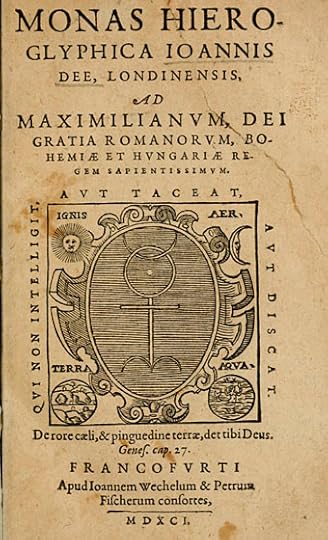
I swear I didn't go hunting for this. Among the various library collections at the Internet Archive one can find The Getty Alchemy Collection, a substantial gathering of very old alchemical texts scanned in a variety of formats. John Dee's Monas Hieroglyphica caught my eye during a random search, a third edition of his treatise from 1564 in which he describes his Monas Hieroglyphica, a glyph designed to combine symbols of the Sun, the Moon, the Elements and Fire in a single figure.
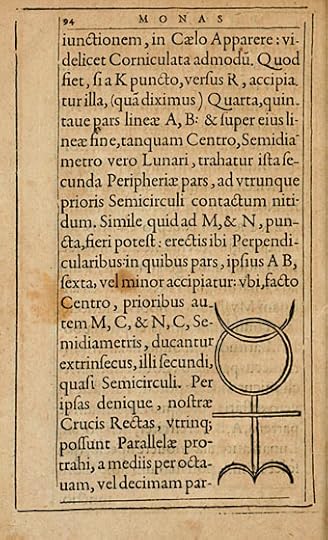
The glyph also intentionally resembles a human form, and Dee relates its individual parts to various astrological and chemical symbols. I've mentioned before that Dee scholar Derek Jarman deliberately based Prospero on John Dee in his 1979 film of The Tempest, giving the magus a scrying wand shaped to resemble the Monas Hieroglyphica.
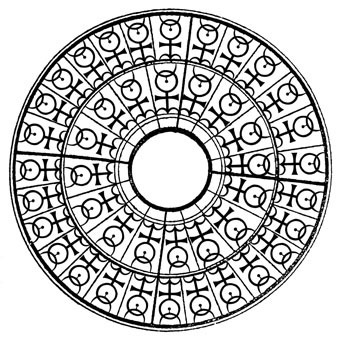
I produced my own variations on the glyph in 2009 when working on the cover of Jeff VanderMeer's novel, Finch. The symbol recurs in Jeff's fictional city of Ambergris and I seem to recall there being some discussion about including this doorway design somewhere in the book. In the end it was incorporated into the cover design in a rather subtle fashion. I think this is the first time the design alone has appeared in public.
The Internet Archive has a few other Dee-related items, including Lists of manuscripts formerly owned by Dr. John Dee; with preface and identifications (1921), a 500-page book by antiquarian and ghost story writer MR James.
Previously on { feuilleton }
• Mister Jarman, Mister Moore and Doctor Dee
• Alchemically Yours
• Laurie Lipton's Splendor Solis
• The Arms of the Art
• Splendor Solis
• Amphitheatrum Sapientiae Aeternae
• The Tempest illustrated
• Cabala, Speculum Artis Et Naturae In Alchymia
• Digital alchemy
• Designs on Doctor Dee
July 25, 2011
Clive Hicks-Jenkins: A Retrospective
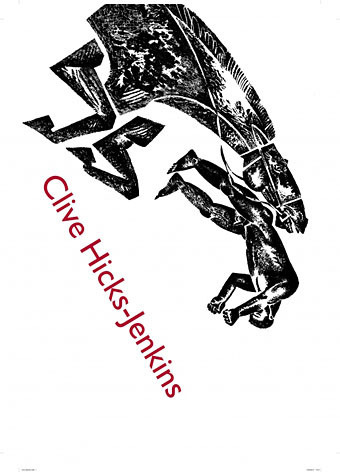
I know I'm not the only person capable of grumbling about London's monopoly on art exhibitions so I'm a little mortified to find I've not mentioned Clive Hicks-Jenkins: A Retrospective, an exhibition which has been running at the National Library of Wales, Aberystwyth, since May. There's no excuse for the oversight since I read all of Clive's blog posts and most of the recent ones have concerned the exhibition and an accompanying monograph published by Lund Humphries.
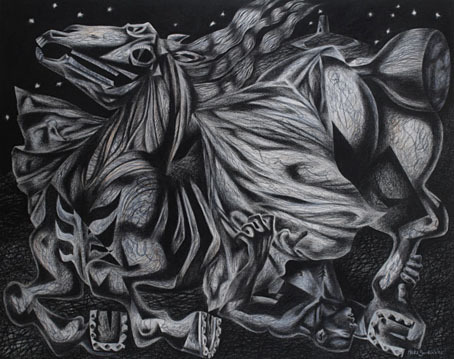
Both Fall (2001).
Among the pieces on display are some of his large Mari Lwyd drawings from 2001, two of which are shown here. I think these were the first works I saw of Clive's and they remain favourites of mine despite their sombre subject matter. The combination of Picasso-like figures, disjunctive perspectives and monochrome nocturnal landscapes make for a very powerful series which Clive discusses in recent blog posts. Not everyone who's this good with monochrome can handle a combination of tones effectively but Clive's recent paintings use colour in a manner which is both confident and immediately striking. Form is Void has a small collection of some of recent works but if you can get to Aberystwyth you can see them up close. Clive Hicks-Jenkins: A Retrospective runs to August 20th, 2011.
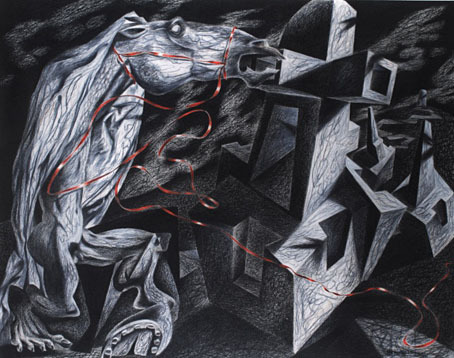
Red Flow (2001).
Previously on { feuilleton }
• Equus and the Executionist
• Dark horses
John Coulthart's Blog
- John Coulthart's profile
- 31 followers











